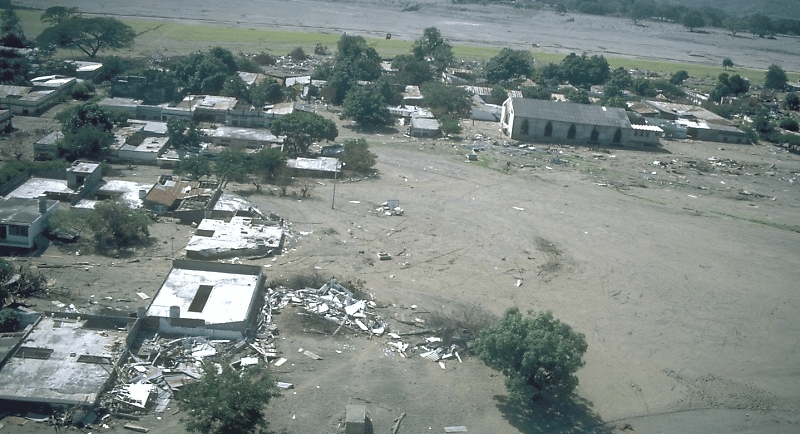Subscribe to our youtube channel today! @medellin_unfiltered
Colombian History Lesson: Armero, Colombia
On November 13, 1985 at 9:03PM, the Nevado del Ruiz peak erupted, taking 23,000 lives and injuring 5,000 more. Though the impact has subsided, this is an example of why science must be listened to.
COLOMBIAN HISTORY
Steve Hamilton
2/17/20254 min read


Colombia has definitely known tragedy, but few events in its history carry the weight of collective grief quite like the Armero disaster. It's something that I had no idea about. If you know me, you know about my curiosity and love for Chernobyl and the disaster that happened there. about 6 months before that disaster, there was one in Colombia that largely snuck by. Granted, the news about Colombia was much more focused on the terroristic reign of a psychopathic serial killer during that time.
It wasn’t just a natural catastrophe; it was a failure of governance, a blind spot of human arrogance in the face of nature’s relentless power. On November 13, 1985, the Nevado del Ruiz volcano erupted, triggering a lahar—an unstoppable wall of mud and debris—that buried the town of Armero, killing over 23,000 people in a matter of hours. It remains one of the deadliest volcanic disasters in history, a grim testament to warnings ignored and lives lost in the cruelest way possible.
A Town That Never Had a Chance
Armero wasn’t just a name on a map; it was a thriving agricultural town, home to 31,000 people who lived in the shadow of Nevado del Ruiz, a large volcanic mountain peak that overlooked the town. They had heard the warnings before—rumblings from the volcano, scientific reports cautioning of an impending disaster—but life continued as usual. The last significant eruption had been over a century prior, and for many, the danger felt distant, abstract.
The government’s response was sluggish at best, criminally negligent at worst. Scientists had urged authorities to evacuate the region in the months leading up to the eruption. The hazard maps detailing possible mudflow paths existed, but bureaucratic inertia and disbelief in the severity of the threat meant that few people ever saw them. When the volcano finally erupted at 9:09 PM, the people of Armero were left defenseless against what came next.
The Night Hell Came Down the Mountain
The eruption itself wasn’t the killer. It was what it set in motion. The intense heat from the explosion rapidly melted the glaciers atop Nevado del Ruiz, sending a cascade of mud, water, and volcanic debris racing down the mountain’s slopes at speeds of up to 60 kilometers per hour. The lahar didn’t just engulf Armero—it obliterated it. Homes, streets, businesses, churches—all consumed in a churning sea of destruction.
Survivors recalled the horror of waking up to a deafening roar, a black wall of death swallowing everything in its path. The lahar hit Armero just before midnight. By dawn, the town was gone, reduced to an apocalyptic wasteland where only the highest structures peeked above the mud. Families were separated, children buried alive, and entire bloodlines erased in mere moments.
The air was filled with the sound of people crying for help, but for most, no help would come. Roads were impassable, communication lines severed. The disaster response, delayed and uncoordinated, meant that many who could have been saved perished in the thick, suffocating sludge, waiting for a rescue that would never arrive in time.
Omayra Sánchez: The Face of a Nation’s Sorrow
If Armero’s tragedy could be encapsulated in a single image, it would be the haunting photograph of Omayra Sánchez. The 13-year-old girl was trapped in the debris of her collapsed home, pinned by water and rubble. Journalists and relief workers surrounded her, capturing her final hours as she clung to life with an eerie calmness that broke hearts worldwide.
Her face—eyes wide, skin pale—became the symbol of Armero’s suffering, not just for the sheer tragedy of her situation, but for what it represented: a young life stolen, a disaster that could have been mitigated, and a government that had failed its people.
Omayra died after three days of suffering, her final words a whisper of resignation. Her image is burned into Colombia’s memory, a stark reminder of how unprepared the country was for a tragedy of this scale.
The Aftermath: A Wound That Never Healed
Armero never recovered. There was no rebuilding effort; the land itself was deemed too unstable, forever marked by the scars of that night. Survivors were relocated to neighboring towns, but nothing could replace what was lost. Some spent years searching for missing loved ones, holding onto the fading hope that someone, somewhere, had made it out alive.
The disaster led to changes in Colombia’s emergency response protocols. The Colombian Geological Service and disaster preparedness agencies became more vigilant, ensuring that hazard maps and evacuation procedures were taken seriously in the future. Yet, even with improved awareness, tragedies like Mocoa in 2017—a deadly landslide that killed over 300 people—proved that nature still has the upper hand when warnings go unheeded.
A History Lesson Written in Blood
What happened in Armero was more than just a natural disaster. It was a preventable catastrophe, one that should have never reached the scale it did. The town’s death toll wasn’t solely the work of a volcano; it was the result of governmental failure, lack of preparedness, and a dangerous underestimation of nature’s power.
Today, what remains of Armero is a ghost town, a silent memorial to the lives lost. The ruins stand as a chilling reminder of what happens when warnings are ignored. The tragedy is still spoken about with a mixture of sorrow and frustration, a national wound that, even decades later, refuses to fully heal.
And perhaps, that is the real lesson of Armero: the past doesn’t just live in history books. It lingers, waiting for us to listen. Because if we don’t, we may find ourselves repeating the mistakes of those who came before, standing in the path of disaster, believing it will never come.
Medellin Unfiltered
Discover the real Medellin, without filters.
CONTACT US
info@medellinunfiltered.com
© 2024 GWM Ventures. All rights reserved.
LEGAL




